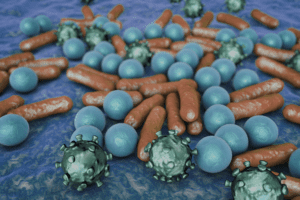- PRODUCTS
-
UP.SIGHT™ 2nd GenNEW
Optimized For Proof Of Monoclonality, Colony Tracking, Confluency, & Titer Measurement -
F.SIGHT™ 2.0
Optimized For Rapid Dispensing of Fluorescent Cells -
C.SIGHT™ 2.0
Optimized for Powerful Dispensing of Unlabeled Cells -
B.SIGHT™
Optimized For Rapid Microbial Single-Cell Isolation and Cultivation -
F.SIGHT™ OMICS
Optimized For Single-Cell-Omics -
F.SIGHT™
Optimized For Affordability And Flexibility -
C.SIGHT™
Optimized for Affordable Cell Line Development -
Compare Products
Decide which one is right for you - Help Me Choose
-
UP.SIGHT™ 2nd GenNEW
- APPLICATIONS
- RESOURCES HUB
- COMPANY
- SHOP
Enabled by single prokaryotic cell sequencing using the B.SIGHT™ single bacteria dispenser
A recent study from the Karlsruhe Institute of Technology and IMTEK department at the University of Freiburg in Germany, conducted using our single-bacteria dispenser, the B.SIGHT™, led to the identification of microbial “dark matter,” or uncultured microorganisms, in a complex sample derived from a wastewater treatment plant.
Researchers reported the first successful use of a pioneering single cell dispensing system for label-free isolation of single bacteria from wastewater, demonstrating the potential of this technique for single-cell genomics and other downstream applications.
This novel commercial tool enabled the sorting of single environmental cells without subjecting them to stress-causing labeling and prevented the sorting-stress seen with commonly used FACS protocols. The genome retrieval outcome was greater than 80% and, for 50.1% of these, resulted in the sequencing of 50 cells identified as members of Patescibacteria/Candidate Phyla Radiation (CPR). The thus collected genomes of single and co-assembled cells are a valuable resource for advancing our knowledge of Patescibacteria/CPR.
Lorem
ipsum dolor
- Lorem Ipsum is simply dummy text of the
- Lorem Ipsum is simply dummy text of the
- Lorem Ipsum is simply dummy text of the
- Lorem Ipsum is simply dummy text of the
Enabled by single prokaryotic cell sequencing using the B.SIGHT™ single bacteria dispenser
A recent study from the Karlsruhe Institute of Technology and IMTEK department at the University of Freiburg in Germany, conducted using our single-bacteria dispenser, the B.SIGHT™, led to the identification of microbial “dark matter,” or uncultured microorganisms, in a complex sample derived from a wastewater treatment plant.
Researchers reported the first successful use of a pioneering single cell dispensing system for label-free isolation of single bacteria from wastewater, demonstrating the potential of this technique for single-cell genomics and other downstream applications.
This novel commercial tool enabled the sorting of single environmental cells without subjecting them to stress-causing labeling and prevented the sorting-stress seen with commonly used FACS protocols. The genome retrieval outcome was greater than 80% and, for 50.1% of these, resulted in the sequencing of 50 cells identified as members of Patescibacteria/Candidate Phyla Radiation (CPR). The thus collected genomes of single and co-assembled cells are a valuable resource for advancing our knowledge of Patescibacteria/CPR.
A recent study from the Karlsruhe Institute of Technology and IMTEK department at the University of Freiburg in Germany, conducted using our single-bacteria dispenser, the B.SIGHT™, led to the identification of microbial “dark matter,” or uncultured microorganisms, in a complex sample derived from a wastewater treatment plant.
Researchers reported the first successful use of a pioneering single cell dispensing system for label-free isolation of single bacteria from wastewater, demonstrating the potential of this technique for single-cell genomics and other downstream applications.
This novel commercial tool enabled the sorting of single environmental cells without subjecting them to stress-causing labeling and prevented the sorting-stress seen with commonly used FACS protocols. The genome retrieval outcome was greater than 80% and, for 50.1% of these, resulted in the sequencing of 50 cells identified as members of Patescibacteria/Candidate Phyla Radiation (CPR). The thus collected genomes of single and co-assembled cells are a valuable resource for advancing our knowledge of Patescibacteria/CPR.
Although metagenome-assembled genomes (MAGs) have several obvious advantages, they severely limit the ability to identify horizontally derived or otherwise ambiguous portions of the genome, do not resolve heterogeneities between close relatives, and do not allow 16S rRNA gene-based analyses. Therefore, a combination of MAGs with single amplified genome (SAG) data would be desirable to further identify elusive microbial dark matter such as Patescibacteria/CPR.

The study’s investigators demonstrated for the first time that single cell dispensing is a successful and expandable method for examining microbial dark matter from environmental samples. This method will enable diverse future applications in the fields of genomics, transcriptomics and culturomics. In addition, the unique technique of cell detection by photographic imaging is a distinct feature of this method that shows high potential for future microbial applications.
Reference
Wiegand S, Dam HT, Riba J, Vollmers J, Kaster AK. Printing Microbial Dark Matter: Using Single Cell Dispensing and Genomics to Investigate the Patescibacteria/Candidate Phyla Radiation. Frontiers in Microbiology. 2021; 12: 1512. DOI:10.3389/fmicb.2021.635506





